Yearning for a cheese that would be on the table quickly, I chose Caerphilly this week. It has Welsh origins, and is a lightly pressed cheese that ripens in 3 weeks.
Here is a bit of history about Caerphilly from Wikipedia;
Caerphilly cheese is a hard, white cheese that originates in the area around the town of Caerphilly in Wales, although it is now also made in England, particularly in the South West and on the English border with Wales. It was not originally made in Caerphilly, but was sold at the market there, hence taking the town’s name.
Caerphilly is a light-coloured (almost white), crumbly cheese made from cow’s milk, and generally has a fat content of around 48%. It has a mild taste, with its most noticeable feature being a not unpleasant slightly sour tang.
It is rumoured that the cheese was developed over time to provide the coal miners of the area with a convenient way of replenishing the salt lost through hard work over ten hour shifts underground and so was a staple of the diet of the coal miners.
So here is my method for making it. I used the recipe out of Making Artisan Cheese by Tim Smith and modified it a little.
- 7.5 litres whole milk (2 gallons)
- 1 quarter teaspoon (about 2 ml) mesophillic culture
- 1 eighth teaspoon (about 1 ml) calcium chloride diluted in 60ml cool unchlorinated water
- 1 half teaspoon (about 3 ml) liquid rennet diluted in 60ml cool unchlorinated water
- 2 tablespoons non-ionised salt
Heat milk to 32°C user double boiler (I use a smaller saucepan under the large pot).
Add the calcium chloride if you are using homogenised milk. Stir for a minute. Then add the starter culture and stir for another minute. Cover and let rest for thirty minutes at target temperature.
Maintaining the temp of 32°C (90°F), add the rennet to the milk, stir for two minutes, then cover. Let mixture sit for forty minutes at the target temperature, or until you get a clean break.
Cut the curds into 6mm (¼ inch) cubes, keeping the size as uniform as possible.
Slowly raise the temp to 33°C (92°F); this should take about ten minutes. Hold the curd at the target temp for forty minutes and be sure to stir frequently to keep the curds from matting. Let rest at target temp for five minutes.
Drain the curds into a cheese cloth lined colander, and let whey drain for a 5 minutes. Cut the curds into 2.5 cm (1 inch) thick slabs, and stack on top of one another. Turn the stack over, top to bottom, two times in ten minutes. This will assist in draining a lot of whey from the curd.
Using your clean hands, break the curds into thumbnail-sized pieces, and blend with salt.
Fill a cheese cloth-lined 1kg cheese mould with the salted curds.
Cover the curd with one corner of the cheese cloth, lay the follower on top, and press at 5kg (10 pounds) for ten minutes.
Remove the cheese from the press, take it out of the mould, and unwrap the cheese cloth. Turn the cheese, and rub a layer of salt on both top and bottom before rewrapping with cheese cloth. Press at 5kg (10 pounds) for ten minutes. Repeat the same procedure (salt), pressing at 7.5 kg (15 pounds) for twenty minutes. Repeat the same procedure, pressing at 7.5 kg (15 pounds) for sixteen hours. I finished this stage at 6 pm on Saturday evening, so I had to wait until 10 am Sunday morning for the next part.
Take the cheese out of the cheese mould, and let it air dry on a cheese mat and cheese board for about 3-4 days. Make sure you turn the cheese several times a day to ensure even drying and fat distribution.
When the cheese is dry to touch, it is ready to be ripened. Place in your cheese cave at 13ºC (55ºF) at 80-85% humidity for three weeks, turning several times a week. No need to wax this cheese. It will form a rind, and if any mould develops, simply rub the cheese with cloth dipped in some salty water. The salt in this cheese should retard mould growth anyway.
At this time of the year in Australia, you could find a cold cupboard to ripen your cheese in if you don’t have a fridge that you can get warm enough.
If you liked this post, and want to learn more about cheese making, then pop on over to my cheese making blog called Little Green Cheese. It is full of recipes, tips, techniques, video tutorials, and even an eBook to make your home cheese making endeavours a huge success. Click the banner below to be whisked away to the wonderful world of curd nerds!

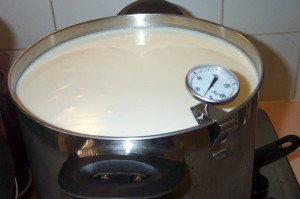
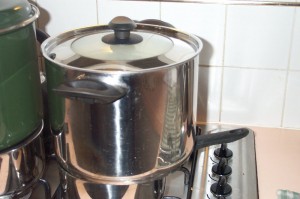
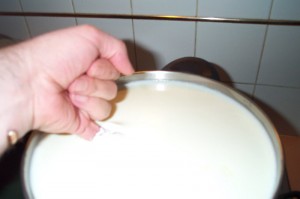
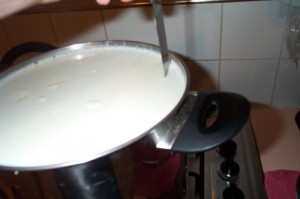
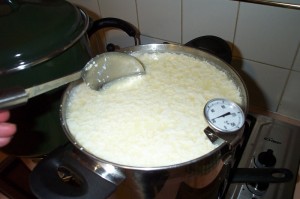
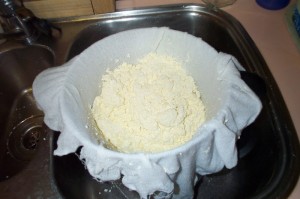
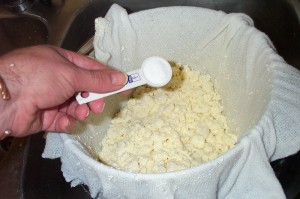
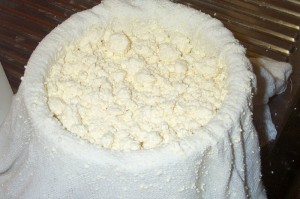
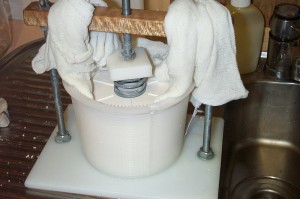
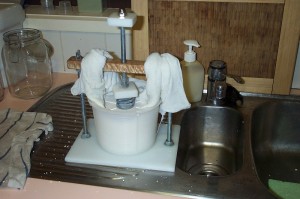
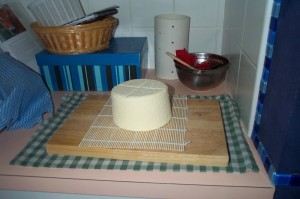
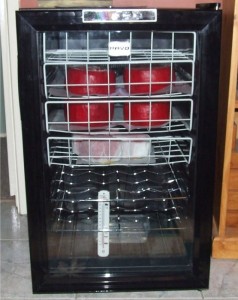

This looks like a very pretty cheese even right after making.
I’m sure it will be a very pretty tasting cheese in just a short wee while.
Enjoy!
That’s quite the setup! My husband and I tried making cheese about 6 months ago and failed. He’s afraid to try again, but just LOVES cheese. Glad I came across your site 🙂
i’m a beginner to make cheese. this site is very helpfull to me. i hope i can make cheese as good as you are. thanx Gavin 🙂
Gavin
You should be so proud of yourself and know that i am truly grateful to have stumbled over your weatlh of information and inspiration!!
I have a blank canvas a new home built in Perth. We havent even got soakwells in so rainwater tanks are going in with over flow to a small pool when the banker permits.
Ive been making my own washing powder and have been cloth napping my 11month old her whole life so far (including a month overseas!)
So Im pretty much at where you were afew years ago … about to embark on a greener way that makes for a happier way of living also.
Thanks agian for such a fabulous blog im hooked !! 😛
heres to food that tastes how it should!!
Hi Emma W,
Thanks for the kind words. Sounds like you are eager and have already started you journey towards a greener lifestyle. Just be warned, there is no final destination, so enjoy the ride. 🙂
Gav x
I have been following your website for a while now, and have been inspired to try and be greener, and more self sufficient. I just bought my first compost bin, and am eagerly filling it up with scraps, and have started a small vege garden, as I only rent, it is in any container I can find. I recently attended a cheesemaking course, and this weekend I made my first farmhouse cheddar(Ricki Carroll). I have been airing it for the past couple of days, but this morning noticed it has some mould on the surface, I also don’t think I pressed it enough because the surface isn’t smooth, but all rough still. Do you have any suggestions? I will give it another go this weekend, I am sure it is all trial and error. Love the site, keep up the inspiring work. Thanks, Jo.
Hi Jo,
Thanks for dropping by. Glad that my adventures have been able to help you on your own journey.
To get rid of the mould, make a brine solution and wipe the cheese with a brine soaked cloth. This will inhibit the mould growth.
Send me an email and I will give you some more tips
Gav
Hi,
Thanks for your reply, I tried to send an email and it says my default mail client is not installed, so will have to muck around and fix it then will email you.
Jo.
Hi Gavin thanks for the recipe, I just took mine out of the press and it looks great. Your written recipe has 7.5l of milk but your video has 8l of milk, I went with 8. Thanks again, from Tassie.
Hi Tassie,
8 litres is fine. That is what I use now anyway. The taste is great, but you will have to wait for 3 weeks!
Gav
Hi Gavin,
Not sure if you’re still reading these comments. Congratulations on your website. Agree with other comments about the amount of great information. I’m keen on trying out your recipe of the Caerphilly but just wanted to know how much salt you used all up. How much at the time of breaking up the curds and also on each occasion when pressing per side?
Hi Rose. Did you see the Caerphilly video tutorial I made? It should answer all your questions.
I have tried a few different recipes my sand has jot been successful so far one thing is how do I know how much I’m pressing I bought a press and a ton of stuff cost me like 500$ and none of oily has helped my press does jot say how much I’m pressing I have ordered cearphilly cheese for a while now and it comes with no rind and is fairly moist I don’t think I’m doing it right ??? Help 🤣